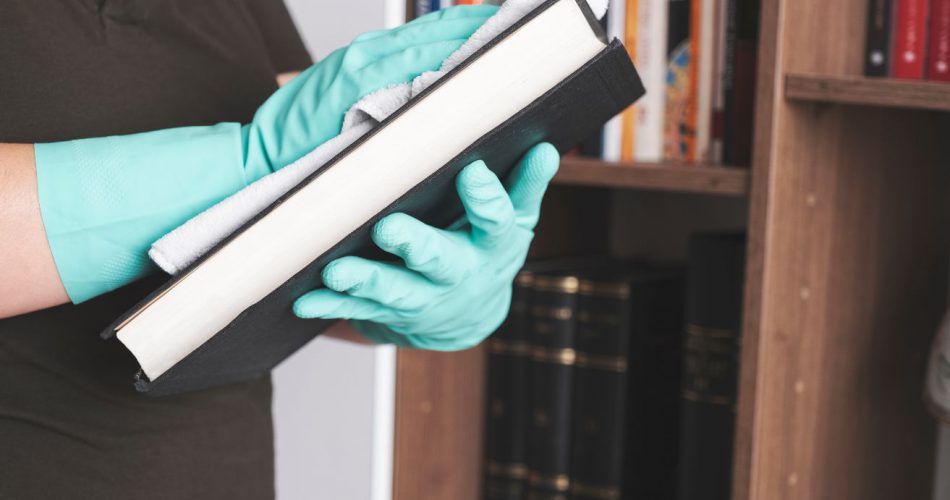Learning how to clean books is crucial, even though it’s not something you’ll have to do regularly. Regardless, it’s still a good idea to be prepared when you do.
However, before we begin, you should know a few things. First, Books and moisture typically don’t mix well. Be careful when using wet cleaning supplies and how much water you use.
Your books may become worse off than they were if you are not careful. Cleaning old or rare books requires a specialized approach. Old books, first editions, and rare books can be delicate.
That’s why we recommend first testing your cleaning techniques on more recent or less expensive books.
This guide will show you the effective ways to clean books.
Let’s begin.
How Often Should You Clean Books?
You need to clean books regularly to maintain your books. Although you don’t have to clean them every day or even every month, you should develop a regular dusting schedule, ideally every few weeks or at least once per month.
This little action keeps your books’ covers and pages clean and maintains their aesthetic appeal. Consider performing a deep cleaning every six to 12 months, depending on your surroundings, for a more thorough cleaning.
Examine your books for damage during a deep clean; get rid of mold or pests; and, if necessary, carefully wipe away stains.
Collectible or valuable books must receive extra attention because they may need professional treatment.
Also Read: How Much is My Book Worth? (Get Instant Quote)
Effective Ways to Clean Books: Step-by-Step Guide
In this section, we’ll go through a step-by-step guide on how to clean books effectively and safely. But first, you need to get your cleaning supplies. Below are the cleaning supplies you need:
- Soft, clean clothes or a book duster
- A soft-bristle brush
- A soft eraser
- A small bowl of warm water
- Mild dish soap (optional)
- A paper towel or blotting paper
- Cotton gloves (optional)
Here’s how to clean books:
Step 1: Find a Clean Workspace
Find a clean place where you can comfortably clean your books. Make sure the environment is clean to avoid extra dust or clutter settling on the books when cleaning.
Step 2: Dust Your Books Carefully
Dusting your books should be a frequent habit to prevent dust buildup. Follow these steps to clean books well:
- Slowly take each book down off the shelf.
- Holding the book closed, dust off the cover with a soft, clean cloth or a book duster.
- Dust the top edge of the pages and open the book slightly.
- Put the book back where it belongs on the shelf.
You should clean your books every few weeks or once a month.
Step 3: Clean Books Thoroughly
Check each book for defects, pests, or mold. Isolate the affected books and give them extra care. Isolate the affected books if you discover mold or signs of pests, and get professional help if necessary.
Rub a soft eraser over the impacted parts of books with soiled or sticky pages. Be careful not to push too firmly, or the paper may get damaged.
Warm water and mild dish soap can moisten a towel to clean a book cover if it is very dirty. Gently wipe the cover, then quickly pat it dry with a fresh, dry cloth.
Leather-Bound Books
Use a leather cleaning or conditioner on books with leather covers to keep the leather supple and shiny. Pay close attention to the product’s instructions.
Valuable and Collectible Books
Consult a professional book conservator for advice on cleaning and preserving these delicate materials if you have a collection of priceless or collectible books.
Maintain Your Bookshelves
Pay attention to your bookshelves even though the books themselves should be your main priority. On the shelves, dust and filth can collect and get onto your books. So, regularly dust and clean them to maintain the condition of your bookcases.

Step 4: Store and Preserve Your Books Well
Once your books are clean, keep them away from direct sunlight, high or low temperatures, and humidity levels in a dry, cool location. To further protect them, think about using acid-free paper or book covers.
Also Read: 7 Interesting Secrets of Rare Book Dealers You Should Know
How to Clean Books to Keep Them Germ-Free
There are two practical strategies to consider if you’re concerned about germs hiding in your books:
- Use Alcohol for Scrubbing Glossy Surfaces
70% Isopropyl Rubbing Alcohol is a reliable option for cleaning the surface of books, especially those with glossy covers or pages. If the cover of your book is glossy, it can usually withstand a light alcohol wipe.
This contains most board books, a few kid’s books, and publications with glossy jackets. Note that alcohol shouldn’t be used to clean Juniper Books jackets.
You can also use rubbing alcohol to clean and refresh the appearance of your glossy jackets.
- Comprehensive Germ Elimination Through Freezing
Another efficient way to guarantee that all bacteria die is to freeze them. When you freeze them, nothing will happen to your books, and most bacteria will die off in a few hours.
Putting the books in the freezer for 48 hours will ensure a complete microbial purge. Additionally, this method is quite successful against conditions like mold, mildew, and persistent pests.
When using this technique, it’s advisable to put it in plastic bags or wrap it in plastic before putting it in the freezer. Thanks to this additional layer of defense, your books will remain secure and germ-free.
Also Read: What You Should Know About International Edition Textbooks
How to Get Stains Out of Your Books
Even though spilled food or beverages might leave difficult-to-remove stains on pages or paper covers, you can still remove them.
Here’s how. Dab a few drops of water on a water-based stain, add a drop of dish soap to a damp microfiber cloth, and gently wipe the stain.
If this doesn’t work, you can use a little rubbing alcohol and a paper towel to remove the stain. You can apply an equal parts water and vinegar solution with a cotton ball or swab to remove grease stains off paper surfaces.
Allow the solution to sit for ten minutes with a weight on top to help the page’s absorption. If the stain doesn’t go away, repeat the process.
Even after the stain has been properly removed, the page can still have creases from the moisture. You can fix this by smoothing the page with an iron while being careful not to scorch it.
Also Read: Find Out-of-Print Books: Expert Tips & Tricks [2023]
Conclusion
As you can see, it’s essential to clean books well. Proper book cleaning is an essential component of book maintenance.
Your books will stay in shape and continue bringing delight and information for decades with regular dusting, occasional deep cleaning, and special care for rare books.
Remember that some cleaning work can significantly increase the lifespan of your cherished books.
